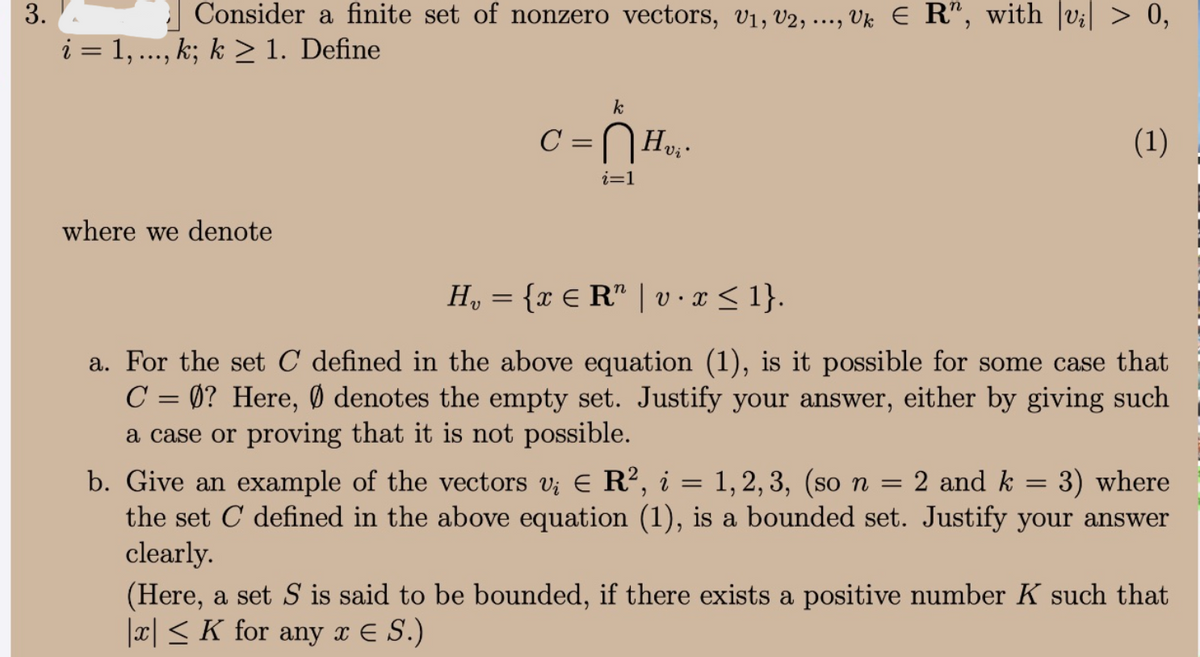| Consider a finite set of nonzero vectors, v1, V2, ..., Vk e R", with |v;| > 0, ..., k; k > 1. Define 3. 1, 2 = k C =N Hvi (1) i=1 where we denote H, = {x € R" | v · x < 1}. a. For the set C defined in the above equation (1), is it possible for some case that C = 0? Here, Ø denotes the empty set. Justify your answer, either by giving such a case or proving that it is not possible. b. Give an example of the vectors v; E R?, i = 1,2, 3, (so n = the set C defined in the above equation (1), is a bounded set. Justify your answer clearly. 2 and k = 3) where (Here, a set S is said to be bounded, if there exists a positive number K such that x| < K for any x E S.)
| Consider a finite set of nonzero vectors, v1, V2, ..., Vk e R", with |v;| > 0, ..., k; k > 1. Define 3. 1, 2 = k C =N Hvi (1) i=1 where we denote H, = {x € R" | v · x < 1}. a. For the set C defined in the above equation (1), is it possible for some case that C = 0? Here, Ø denotes the empty set. Justify your answer, either by giving such a case or proving that it is not possible. b. Give an example of the vectors v; E R?, i = 1,2, 3, (so n = the set C defined in the above equation (1), is a bounded set. Justify your answer clearly. 2 and k = 3) where (Here, a set S is said to be bounded, if there exists a positive number K such that x| < K for any x E S.)
Linear Algebra: A Modern Introduction
4th Edition
ISBN:9781285463247
Author:David Poole
Publisher:David Poole
Chapter6: Vector Spaces
Section6.4: Linear Transformations
Problem 34EQ
Related questions
Question
plz solve question with wxpnation i will give you upvote.

Transcribed Image Text:3.
| Consider a finite set of nonzero vectors, V1, V2, ..., Vk E R", with |v;| > 0,
i = 1, ..., k; k > 1. Define
k
C =
Hvi'
(1)
%3D
i=1
where we denote
H, = {r € R" | v · x < 1}.
a. For the set C defined in the above equation (1), is it possible for some case that
C = 0? Here, Ø denotes the empty set. Justify your answer, either by giving such
a case or proving that it is not possible.
|3D
b. Give an example of the vectors v; E R², i = 1, 2, 3, (so n = 2 and k = 3) where
the set C defined in the above equation (1), is a bounded set. Justify your answer
clearly.
(Here, a set S is said to be bounded, if there exists a positive number K such that
|x|< K for any x E S.)
Expert Solution
This question has been solved!
Explore an expertly crafted, step-by-step solution for a thorough understanding of key concepts.
This is a popular solution!
Trending now
This is a popular solution!
Step by step
Solved in 3 steps with 3 images

Recommended textbooks for you

Linear Algebra: A Modern Introduction
Algebra
ISBN:
9781285463247
Author:
David Poole
Publisher:
Cengage Learning

Algebra & Trigonometry with Analytic Geometry
Algebra
ISBN:
9781133382119
Author:
Swokowski
Publisher:
Cengage

Elementary Linear Algebra (MindTap Course List)
Algebra
ISBN:
9781305658004
Author:
Ron Larson
Publisher:
Cengage Learning

Linear Algebra: A Modern Introduction
Algebra
ISBN:
9781285463247
Author:
David Poole
Publisher:
Cengage Learning

Algebra & Trigonometry with Analytic Geometry
Algebra
ISBN:
9781133382119
Author:
Swokowski
Publisher:
Cengage

Elementary Linear Algebra (MindTap Course List)
Algebra
ISBN:
9781305658004
Author:
Ron Larson
Publisher:
Cengage Learning